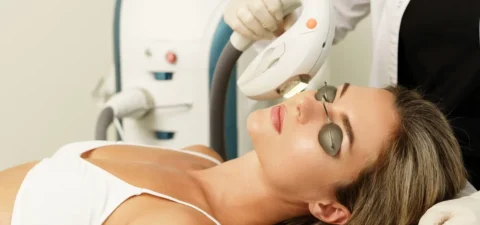For information only. Not meant as advice in any form. Please consult your medical professional or lawyer.
A medical esthetician specializes in traditional and advanced skin treatments that help patients manage or treat their skin conditions. If you want to work in the beauty industry while creating a positive impact on people’s health, then you might want to consider a career as a medical esthetician.
So how can you start a career as a medical esthetician? Before entering the industry, aspiring medical estheticians must first understand what they’re getting into and decide if it’s the best path for them. After that, they need to organize their requirements, attend a medical esthetician school, pass the licensure exam, earn various certificates, and continue learning alongside other professionals to build their careers.
6 Steps to Becoming a Medical Esthetician
According to the U.S. Bureau of Labor Statistics, there are around 47,000 licensed estheticians and medical estheticians in the country. This number is expected to rise as more medical professionals consider a career in the beauty industry because of the current demand.
Medical estheticians help improve the patient’s quality of life by helping them take better care of their skin to increase their confidence and improve their overall health. If you think you’re suited for this kind of career, then read on to know more about the process of becoming a medical esthetician.
Step 1: Understand What Medical Estheticians Do
Medical estheticians (or paramedical estheticians) are a type of skin care specialist that has a similar job description to standard licensed estheticians. But the biggest difference is that a medical esthetician is trained to handle more complicated skin treatments in a medical setting.
Some medical estheticians might work with another skincare specialist or plastic surgeon to assist patients with their treatment or post-surgery care. Others may even work with cancer patients or burn victims. Medical spas are the most popular workplace for many medical estheticians in the country.
Medical Estheticians vs. Nurse Estheticians
Medical estheticians completed a basic esthetics program in a beauty school, but they don’t have the same medical training that nurse estheticians have. A nurse esthetician is a registered nurse that specializes in advanced esthetics and medical aesthetics, so they can perform more intensive medical treatments than medical estheticians can.
Anyone who wants to become a nurse esthetician needs to enroll in another school to finish a nursing degree and register as a nurse first before getting their esthetician license.
What They Do
A medical esthetician’s role depends on the setting and type of body treatments that a clinic or hospital offers. Their main role is to assist the plastic surgeon, dermatologist, nurse, or other medical professionals when it comes to advising patients on the best skin care treatment for them.
Medical estheticians may also perform more complicated treatments like laser hair removal, microdermabrasion, eyelash extension, and more. Depending on the specific state law in a location, a medical esthetician may also work on manual lymphatic drainage, permanent makeup treatments, and post-treatment care for plastic surgery patients.
What They Can’t Do
While there are a lot of perks to being a medical esthetician, this job also has a few limitations like performing Botox treatments and operating your own medical spa.
Since Botox treatments are considered a medical treatment instead of cosmetic, medical estheticians aren’t qualified to perform this treatment. It may only be administered by a dermatologist or plastic surgeon. In some states, they also allow a registered nurse, nurse practitioner, or physician’s assistant to perform Botox injections on some patients.
Most states only allow medical spas to be owned by physicians or physician-owned companies. But according to the American Med Spa Association (AmSpa), non-doctors may still own a medical spa through a partnership with a management services organization (MSO). In this case, the medical esthetician must partner with a physician’s company first to perform their treatments. The latter handles medical services while the MSO takes care of the non-medical aspects of the business.
Step 2: Check the Requirements Needed
There isn’t a specific license for medical estheticians, since they are simply general estheticians who work in medical and clinical settings. The type of licensure they need is one in esthetics or cosmetology, but undergoing additional medical esthetician training can be your best bet to gain employment in this field and broaden your job opportunities.
But before getting a license in cosmetology or esthetics, there are certain requirements to meet first depending on the state the participant wants to practice in. Most states require a person to be at least 16 years old with a high school diploma or GED certificate before they may attend a training program for medical estheticians.
Step 3: Attend Medical Estheticians Schools
After organizing and completing the requirements, the next step to becoming a medical esthetician is to enroll and attend an esthetician training program. Many institutions offer a wide selection of cosmetology or esthetics courses, but make sure that they’re approved or accredited by the state or the National Accrediting Commission of Career Arts and Sciences first before signing up.
What to Look for in a Program
Attending an esthetician school nearby might sound like a good idea, but make sure to see what the institution offers first when it comes to quality education. Make sure to ask these questions before enrolling:
- Are they approved by the state or NACCAS?
- Do they offer hands-on applications for real-life patients?
- How updated is the equipment they let their students use?
- How long does the course take? Does the course meet the state requirements for earning a proper certification?
- How long has the school been teaching its esthetics program?
What You Might Learn About
Different institutions offer different curricula for aspiring estheticians, but most of them should include some basic esthetic topics as well as more advanced procedures like:
- Laser treatments (laser hair removal, laser skin resurfacing, and more)
- Permanent makeup treatments
- Eyelash extension
- Manual lymphatic drainage
- Advanced hair removal
Step 4: Pass Licensing Exams
Medical estheticians must obtain a license first before offering treatments to their clients as a professional. Licensing requirements vary per state, but most of them only require applicants to be at least 16 years old and a graduate of an accredited or state-approved esthetics program.
The licensure test consists of oral, written, and practical sections that the applicant must pass. An esthetician license is only valid for a certain number of years before the medical esthetician needs to renew it.
Step 5: Earn Your Certification in Different Treatments
Some medical estheticians start their practice or apply for jobs in hospitals and medical spas, but others pursue continuing education to earn different certifications that allow them to perform certain treatments.
Certifications aren’t necessary for a master esthetician or facial specialist, but getting one gives them a competitive edge over other people vying for the same job position. These certifications also show your passion and dedication to the field of medical esthetics. Additional training also allows medical estheticians to perform more types of treatments for patients who need them.
Step 6: Continue Learning and Building Your Career
Learning about medical esthetics doesn’t end even after earning licensure or certification. Start working closely with other experts in the industry to get a glimpse of how they handle real-life situations.
By assisting nurse estheticians, plastic surgeons, dermatologists, and other medical professionals, you can pick up and master medical treatment techniques you can use in the future.
Widen Your Horizons With Online Esthetics Courses at FACE Med Store
Being a licensed esthetician gives you the opportunity to work closely with clients and improve the quality of their lives using different skin treatments, but working as a medical esthetician broadens your skill set and allows you to serve even more patients. If you’re interested in learning about other esthetic treatments, FACE Med Store offers online courses for aspiring estheticians.
Aside from our online training programs, we also supply hundreds of medical spas, clinics, and other healthcare institutions across the country with different medical tools they need for their practice. Reach out to us today to know more about our products and courses.






